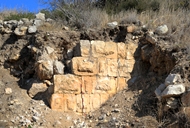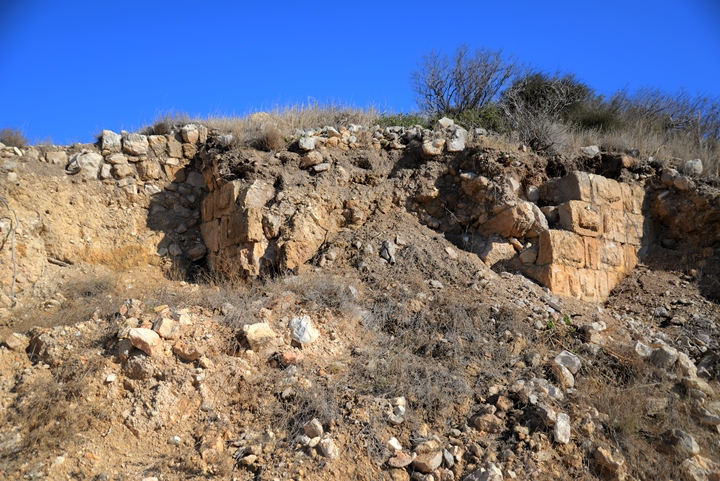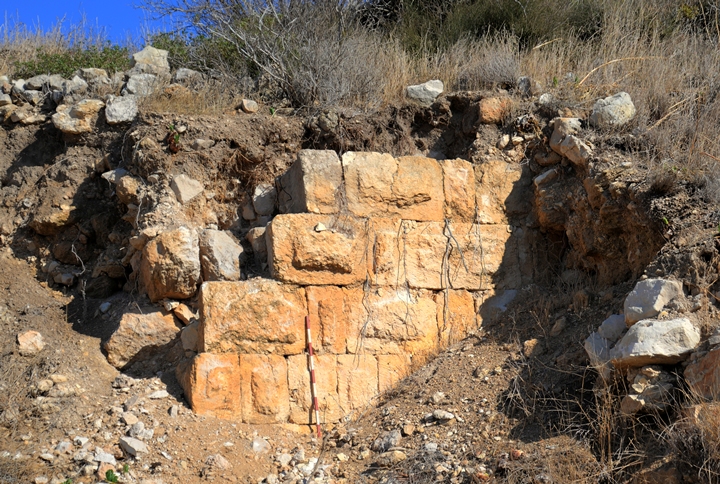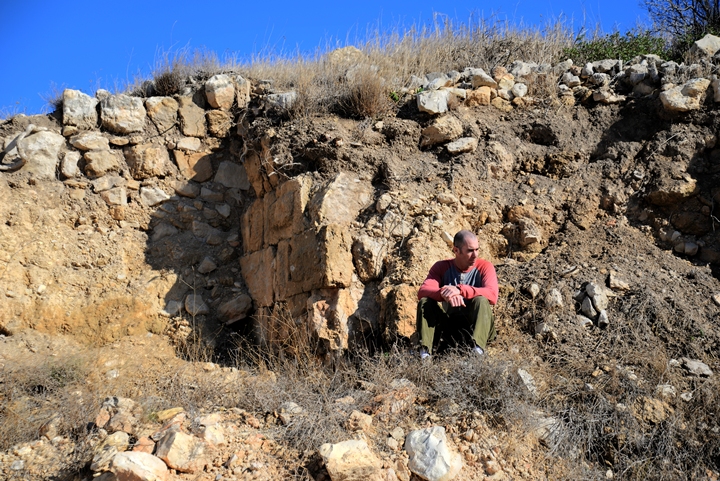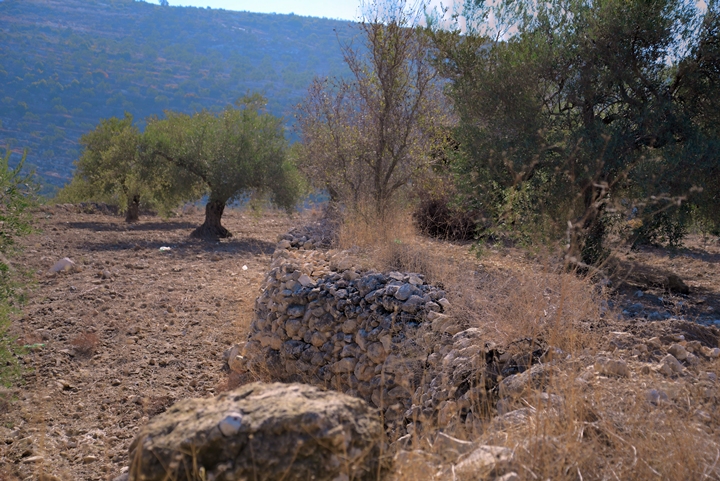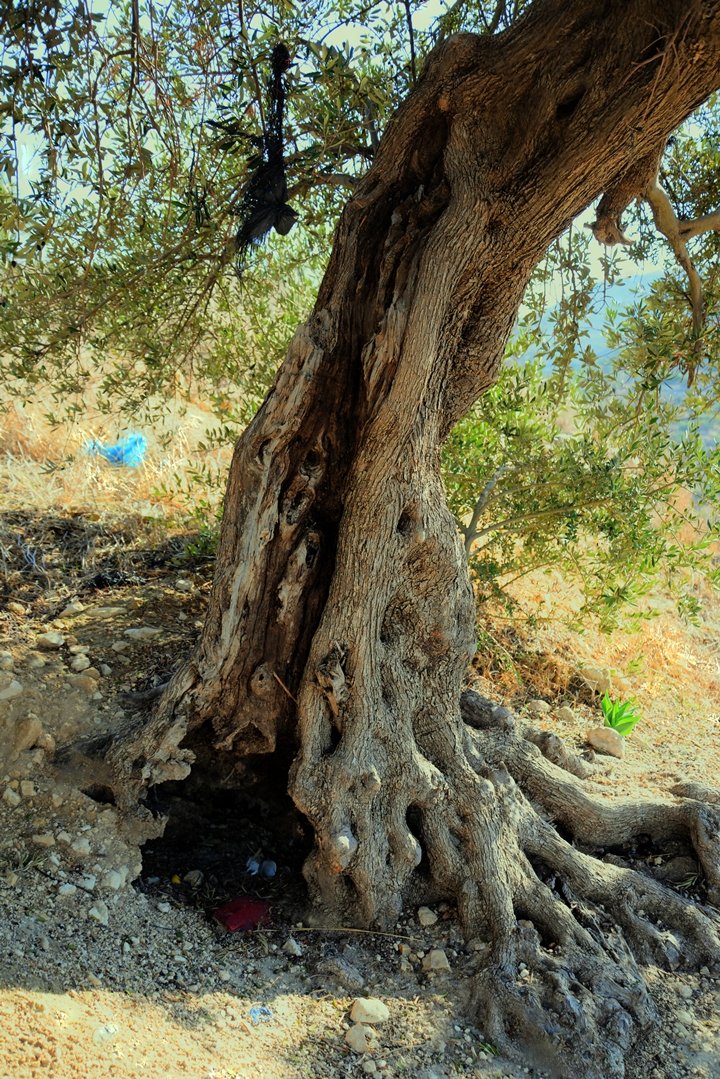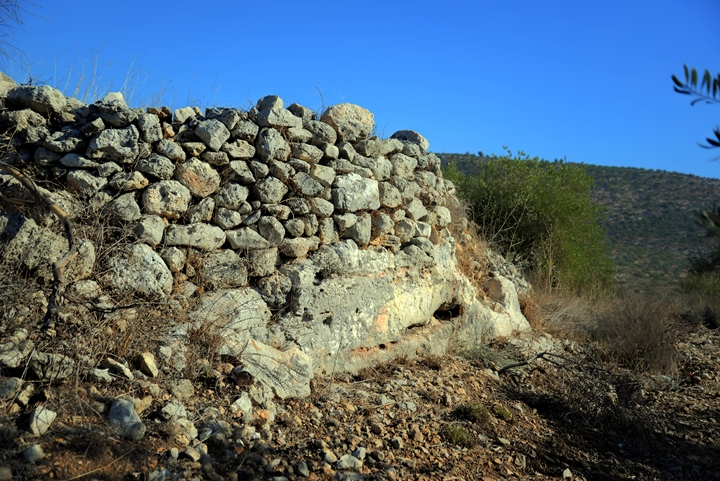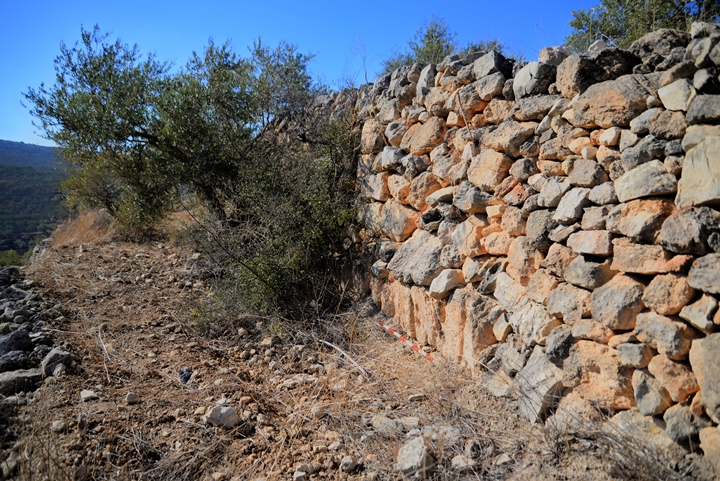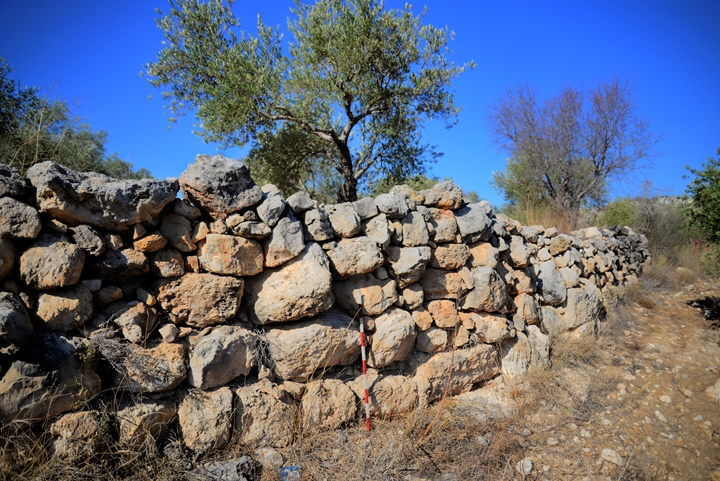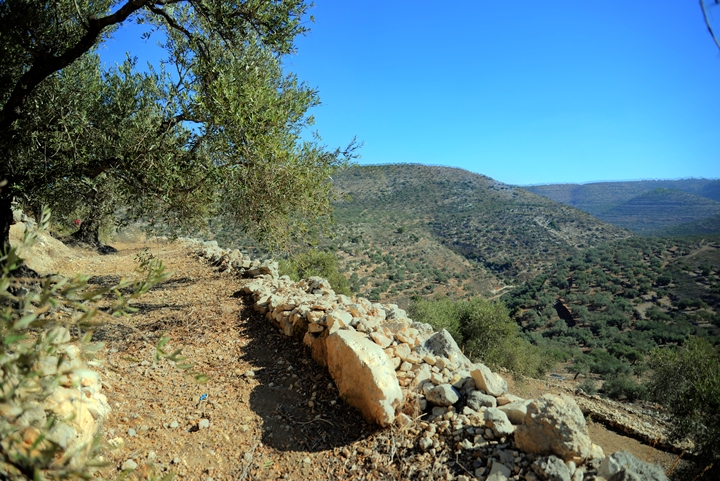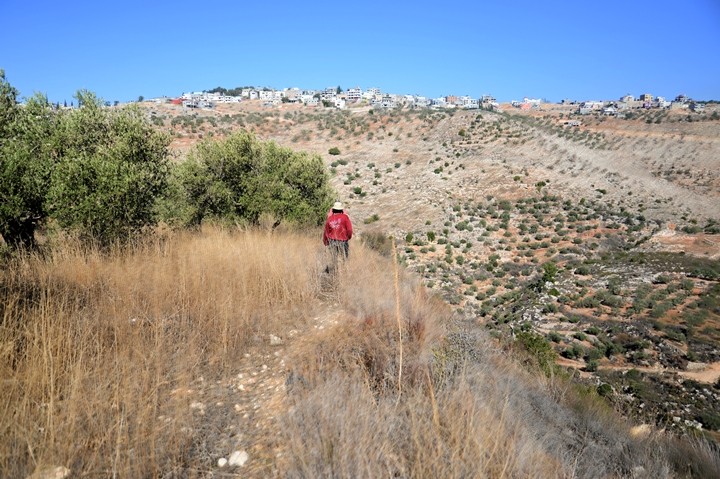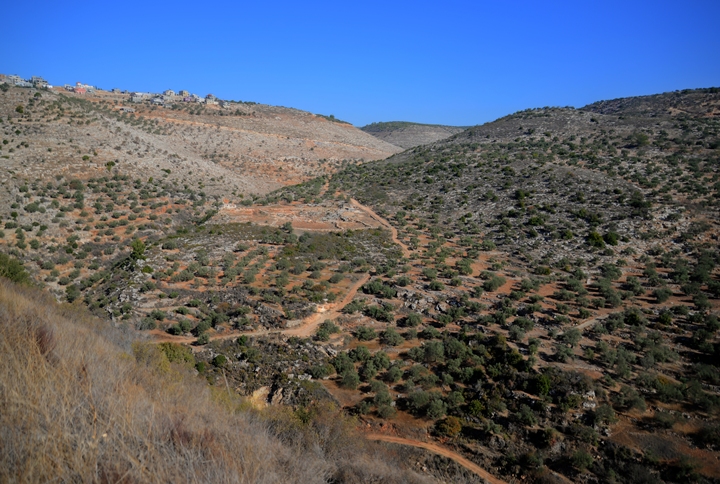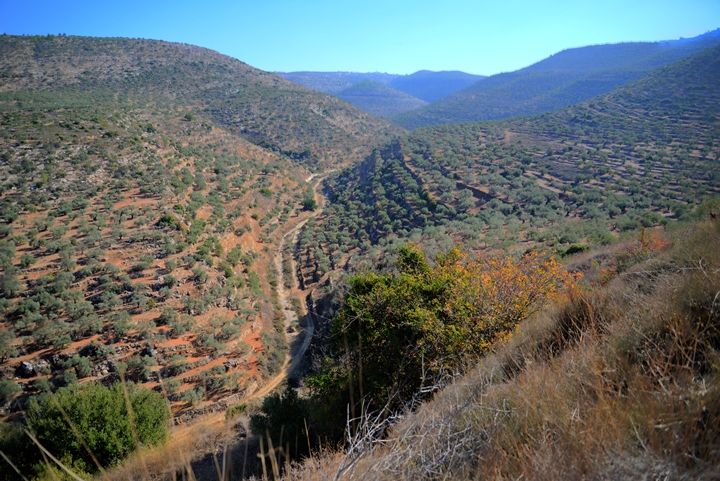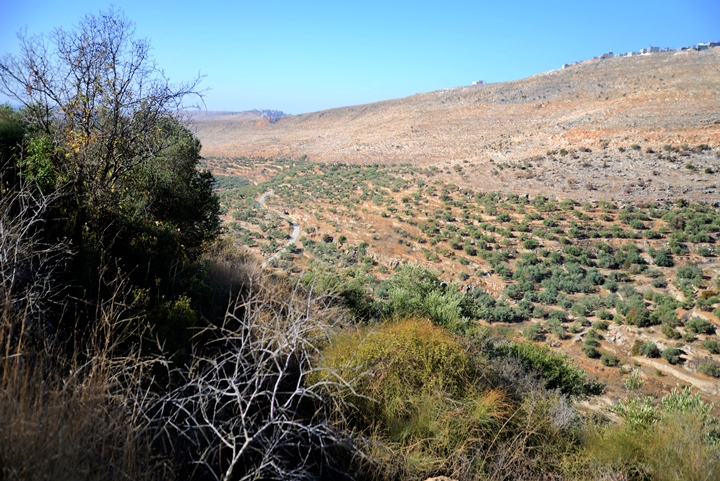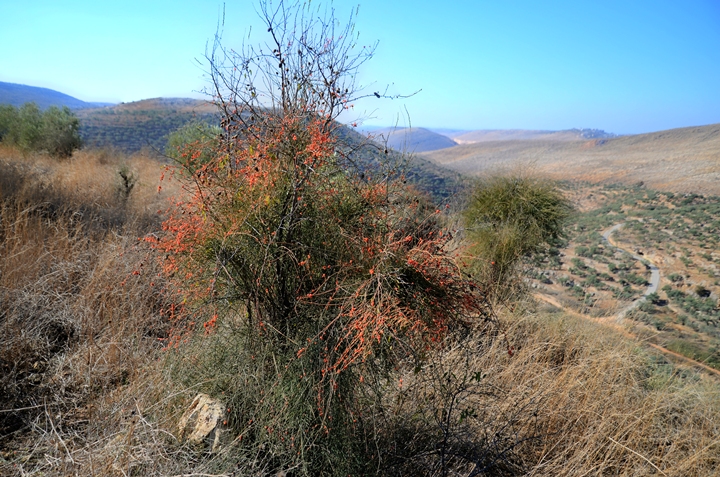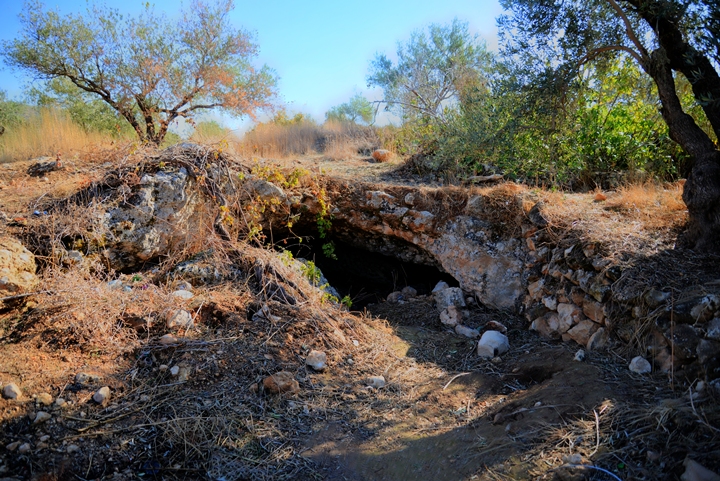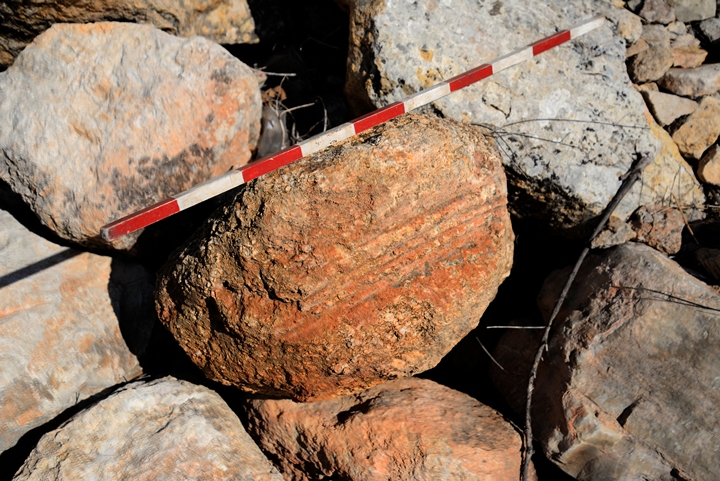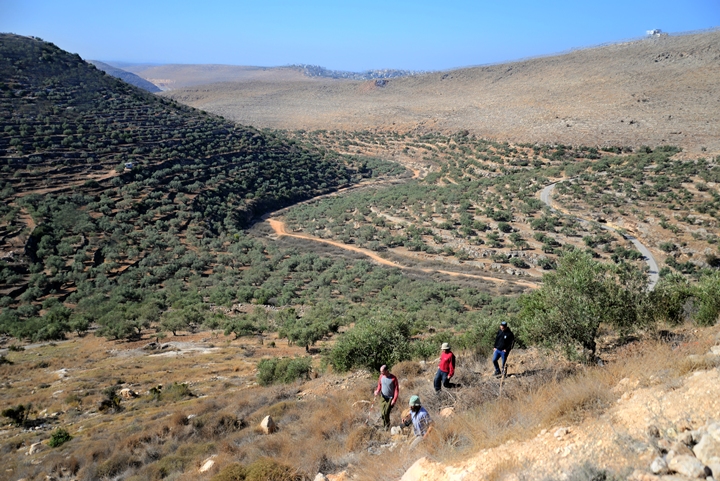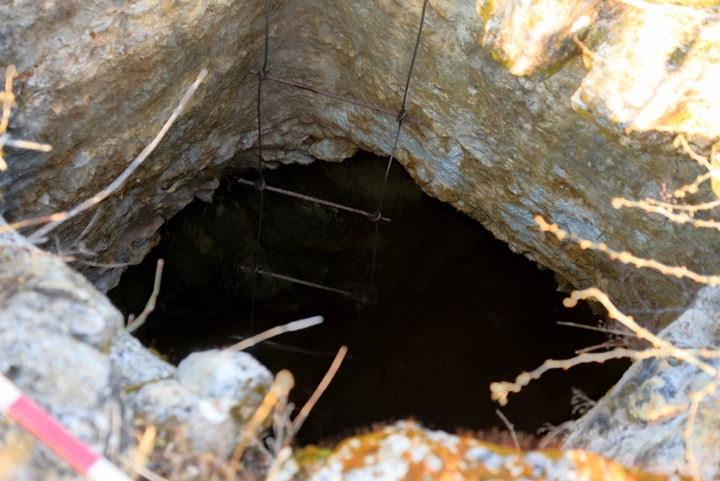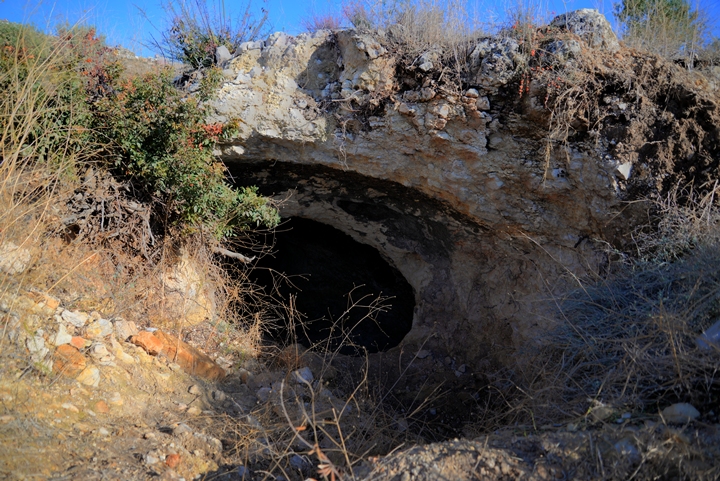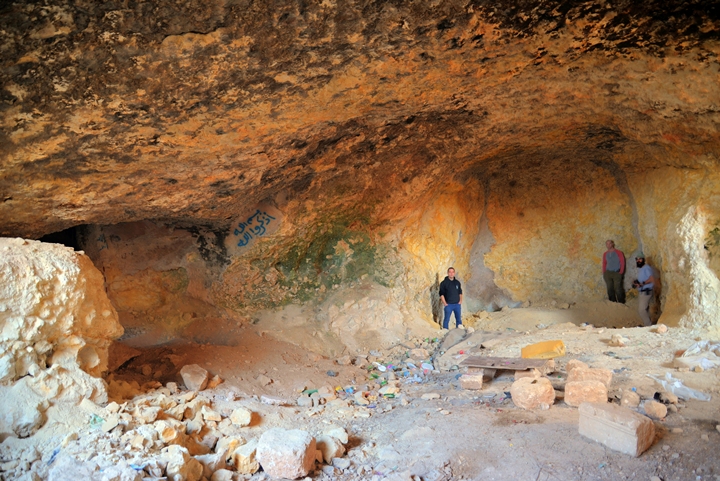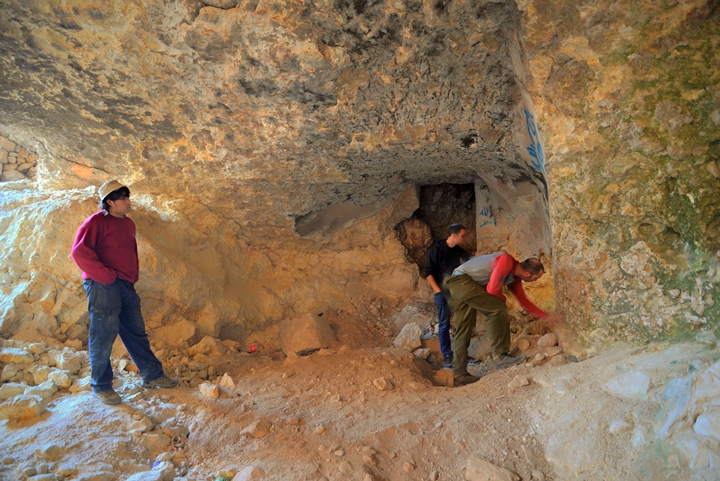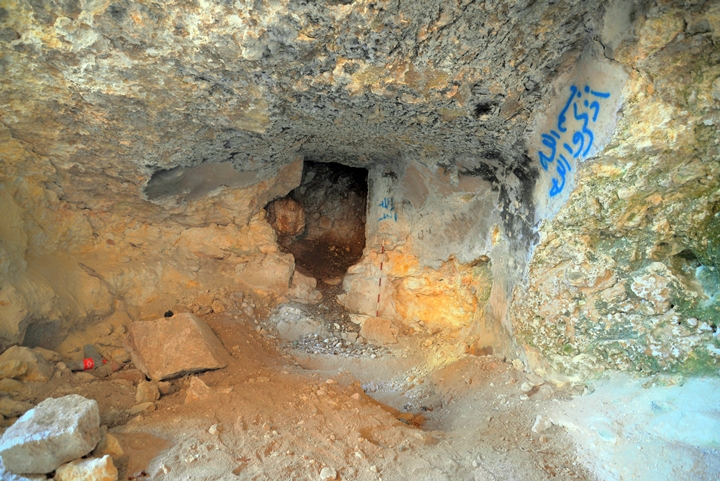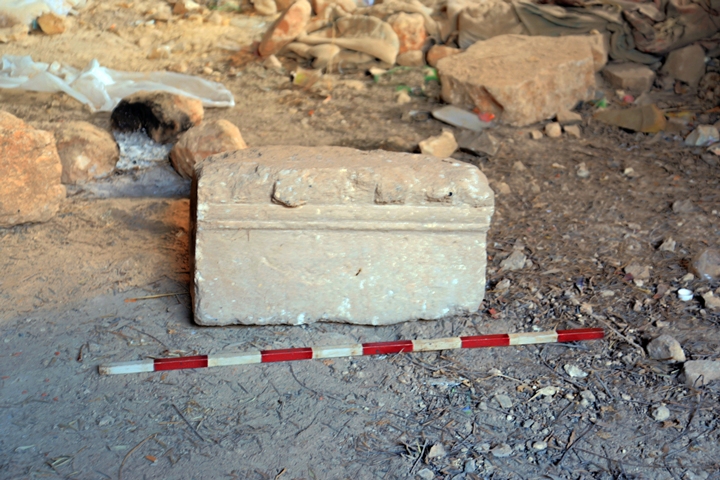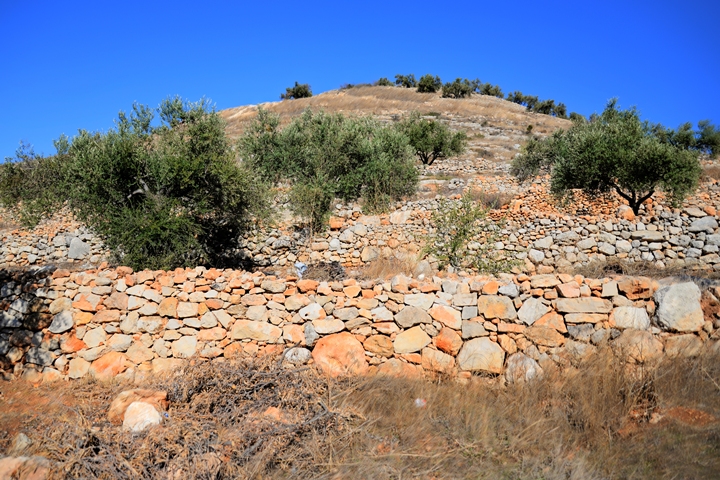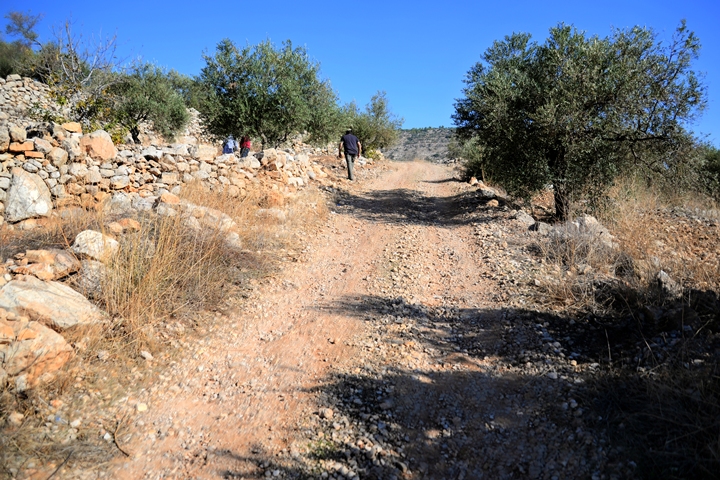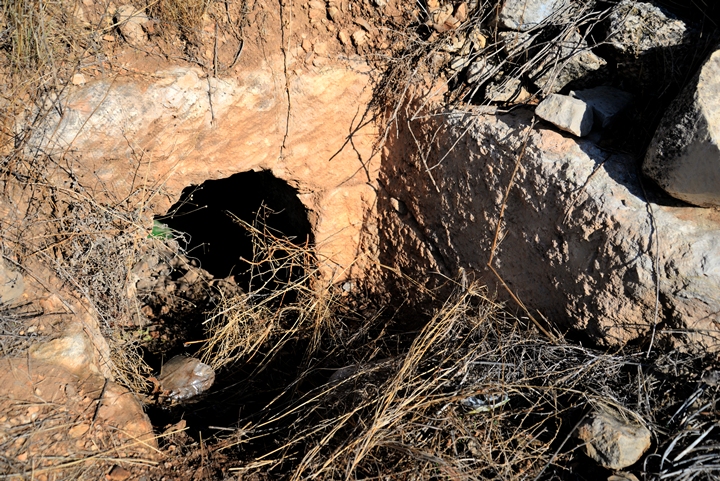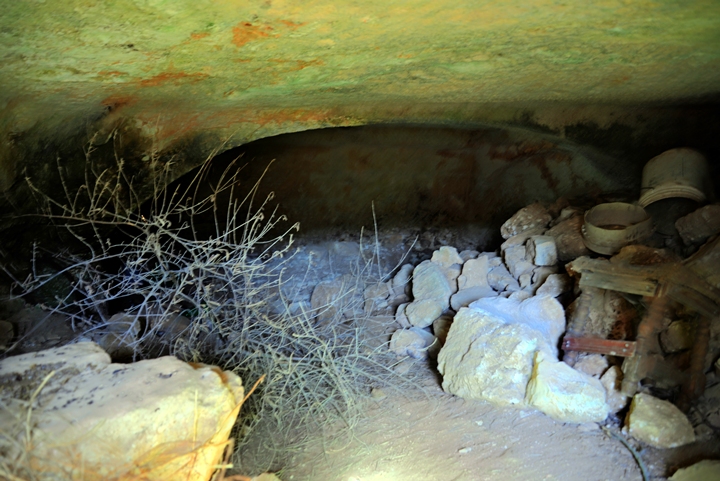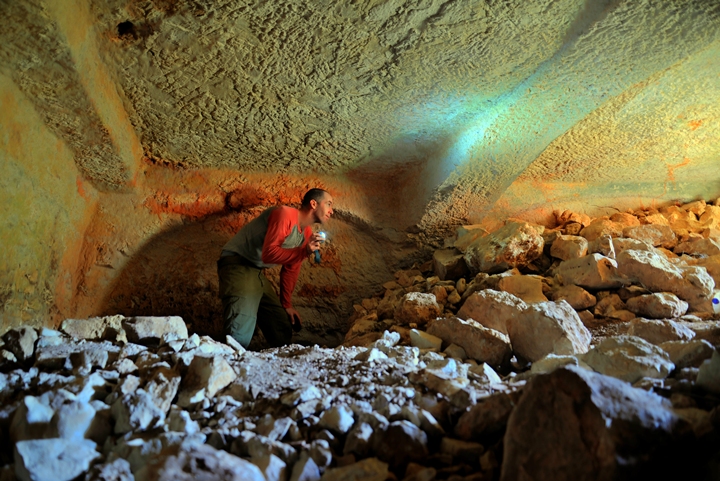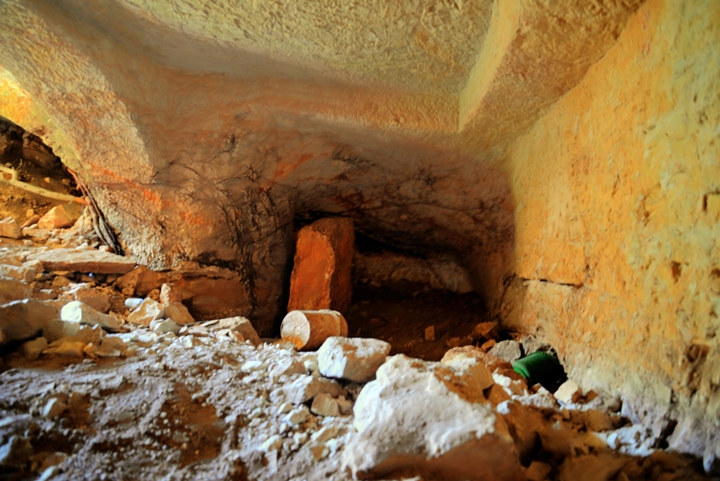Ruins of an unknown Hasmonean/Herodian fortress on a hilltop on the bend of Nahal Natuf stream.
* Site of the Month Dec 2019 *
Home > Sites > Samaria > South > Artabba fortress (Arbel?)
Contents:
Background
Location
History
Photos
* Aerial views
* Ancient Wall
* Survey on the Hill
* Cisterns
* Arches cave
Etymology
Links
Overview:
On a summit of a high hill overlooking a bend in the Nahal Natuf stream are ruins of an unknown Hasmonean-Herodion fortress. A corner of a tower or a periphery wall was found on the southwestern side of the hill top, and other sections of walls are found on the hill, as well as large cisterns and miqvehs. The fortress is one of the earliest Hasmonean fortresses, and may have been named “Arbel”.
This recent discovery is one of the most important discoveries in the archaeological research of the area. It was first published in 2018 by Dr. Dvir Raviv. We joined an expedition to the site in September 2016, and assisted in photography and a short survey.
Location and Map:
An aerial map of the area around the site shows the major points of interest. Ruins of the Hasmonean/Herodian fortress are located on the summit, at an altitude of 364m – more than 100m above the valley of Nahal Natuf stream. A spring, named ‘Ein Artabba, is located 200m west of the hill. Near the spring, on the south west foothills, are remains of a later Roman/Byzantine period settlement – Khirbet Artabba.
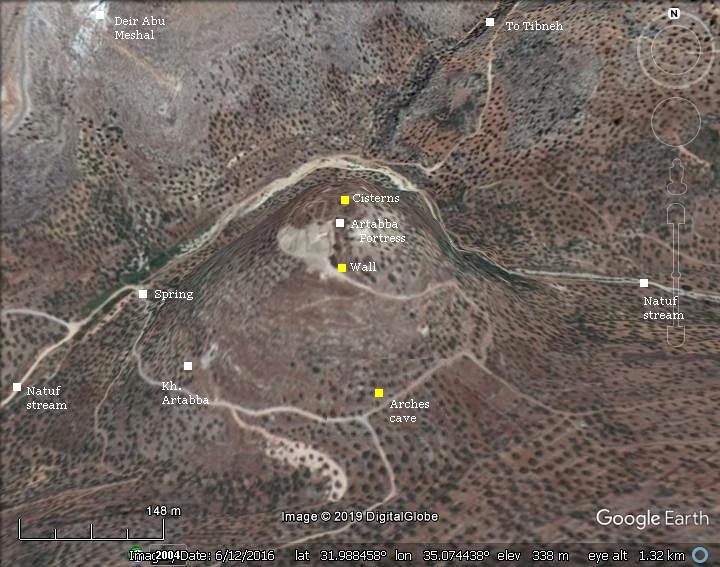
History:
- Hasmonean/Herodian (2nd -1st century BC)
The Maccabees headed the anti-Hellenization rebellion against the Greek Seleucids who controlled the land of Israel during the second half of Hellenistic period (4th – 1st century BC). After a series of successful military campaigns they took control of Judea, liberated the land and created an independent Jewish country in 164 BC – the Hasmonean Kingdom.
The Hasmoneans expanded their small enclave around Jerusalem, building fortresses to protect the newly founded Kingdom. One of these fortresses may have been the newly unearthed fort at Artabba, which was recently discovered after a house was built on the summit and exposed a section of a wall. A survey conducted on the summit revealed 5 large cisterns that supplied water to the fortress, two ritual baths, and storage pits.
Fragments of over 100 ceramics, dated to the Early Hasmonean period, were collected here during the surveys. According to this ceramic analysis, the construction of the fortress is dated to the reign of Simon Maccabee (140-135 BC), or earlier of Jonathan Maccabee (160-143 BC), making it one of the earliest Hasmonean fortress. The fortress may have been called “Arbel”, based on Dvir’s interpretation of 2nd century rabbinic Midrash literature.
Note that a nearby fortress of Hadid, 13 km to the west (see map below), was also built by Simon Maccabee (1 Maccabees 12:38 ): “And Simon built Adiada [Hadid] in Sephela, and fortified it, and set up gates and bars.”. The Hadid fortress was also constructed on a hill above the south bank of Nahal Natuf.
The Artabba fortress was built on the northern border of the Hasmonean Kingdom before it was expanded to the north during the reign of John Hyrcanus (134-104 BC).
A Biblical map is shown here, with Artabba marked as a red square. It is located south west of Thamnatha (Tibneh), an important site on the route from Aphek/Antipatris to Gophna and Jerusalem-Shechem road. During the early Roman period, Thamnatha/ Tibneh was the capital city of the Timna province, which was settled by Jews.
Roads and cities during the Israelite period thru the Roman period, 20th BC- 1st century AD (based on Bible Mapper 3.0)
- Herod (37-4 BC)
According to a decorated stone that was found in cistern III, there may have been a monumental structure built by Herod.
An illustration of the Artabba is shown here, based on initial surveys and directions of Dr. Dvir Raviv. The fortress, overlooking the valley of the Natuf stream, is protected by a peripheral wall. A gate on its south site was protected by towers flanking the entrance. Inside the fortress are five water reservoirs cut in the rock, storage facilities and a Herodian palace. Along the foothills are agriculture terraces planted with olive trees and grapevines, and two farming villages.
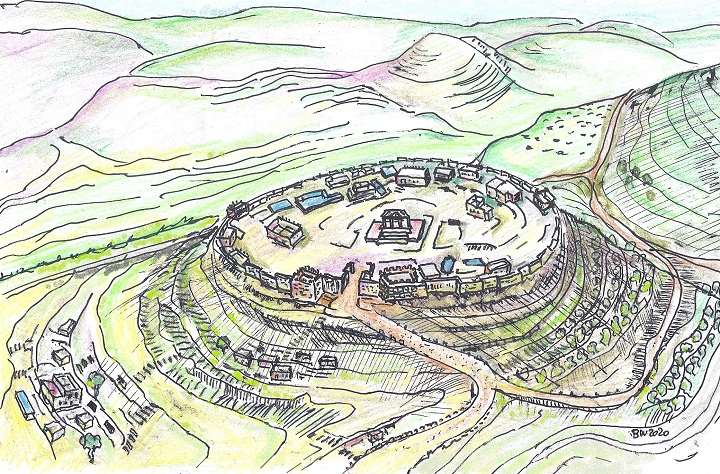
- Roman/Byzantine period
After the destruction of the fortress in Artabba, a new village was built on the south west foothills. The ruins, named Khirbet Artabba, were populated during the Hellenistic and Roman periods. The ruins are spread on 20 dunams.
- Ottoman period
Conder and Kitchener surveyed this area during the Survey of Western Palestine (SWP) in 1873. A section of their map (of sheet 14) is shown here, south of the town Deir Abu Meshal where they identified a Crusader fortress.
They merely noted on this site (V2 p.328): “Traces of ruins.”
In their dictionary the surveyors translated the name ‘Artabbeh’ from Arabic as: ‘moist, fresh.’, based on the Arabic root word ‘ratb’=moist.
Part of maps Sheet 14 of Survey of Western Palestine, by Conder and Kitchener, 1872-1877. (Published 1880, reprinted by LifeintheHolyLand.com)
- Modern Period
Following private development works on the summit in 2015, the antiquities on the hill were first discovered. There was no prior knowledge of the fortress before this, and the finding of this unknown Hasmonean/Herodian fortress was a great surprise. Dr. Dvir Raviv conducted the surveys and published the findings in 2018.
After the discovery of the ancient remains, there are illicit diggings and destruction conducted at the site. There is an urgent need to protect the site, as well as other ancient sites in the region, from further damages to the antiquities. However, due to the lawlessness in Judea and Samaria, this situation seems uncontrollable.
Visit to the site may be allowed only with permission with the Army.
Photos:
(a) Aerial views
A drone view of the hill was captured in September 2016. The orientation is towards the north east. The ruins of the fortress are located on the summit. The access road ascends along the ridge where remains of structures, storage caves and burial caves were discovered. The cars are parked near the Arches cave.
In the far background are the community of Halamish and the Arab village of Deir Nizham, near the ancient site of Tamnatha/Tibneh.
Click on the photos to view in higher resolution…
A closer view of the flat summit is seen next. The flat area covers an area of 22 dunams, measuring 200m long and 150m wide at the broadest place on its south side.
On the south side of the summit, near the newly built house, is a section of an ancient wall. The discovery of the wall, part of an unknown Hasmonean/Herodian fortress, led to extensive survey of the site.
(b) Herodian/Hasmonean Wall
A the edge of a newly constructed road to the summit, a section of two perpendicular walls were exposed. This aerial view shows Dr. Dvir Raviv, who discovered and surveyed the site, is sitting near the corner of the exposed walls.
The next photo shows the corner of two walls from the ground level. This corner of the wall may have been a section of a tower, or a section of a peripheral wall.
The location of this tower is shown on the illustration by a yellow ellipse. A gate was probably located to the west of the tower.
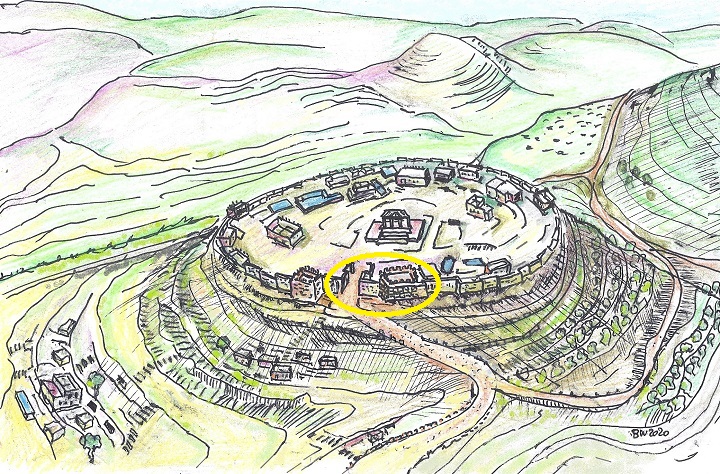
Below is a closer view of the eastern wall, built of large (1m x 0.5m) ashlars stones. The stones have drafted margins and a rough boss in the middle. The stones were placed in heads and stretchers style on some of the courses, a type of wall that is typical of Hasmonean and Herodian building styles.
A closer view of the western section:
(c) On the hill
The relatively flat summit is covered by olive trees.
A closer view of the bark of one of the olive trees:
Retaining walls, assembled from small field stones, support the olive grove.
Some of the walls are built over sections of ancient walls, such as this one where an archaeological measuring stick is located in the following photo.
The next photo shows another section with a base of an ancient wall:
From the edges of the summit are great views of the valley of Nahal Natuf.
We walked along the peripheral edge of the hill, trying to discover antiquities.
A closer view, towards the east, as captured from this spot:
On the north side of the hill are even better views of the valley of Natuf stream. The road along the valley reaches Beit Ello, where the location of another Hasmonean period fortress (‘Eilon’) was suggested by Prof. Avi-Yonah.
On the western side of the hill are view of the Arab village of Deir Abu Meshal, which is located on the hill to the west of the site. Below, in the valley, is the spring of ‘Ein Artabba. On the foothills below are ruins of Khirbat Artabba, with remains of a later settlement dated to the Roman period.
Yet another view of the western side:
On the summit are cisterns. Five large cisterns were discovered so far on the summit.
Architectural elements were also observed during this walk around the edge of the hill. This stone probably covered the vertical opening of a cistern.
Yet another carved stone discovered on one of the walls. Each bar on the archaeological measuring stick is 10cm.
A southern view is shown in the next photo.
(d) Cisterns
On the summit are several large cisterns that served as water reservoirs for the Artabba fortress. The rock of soft chalk made it easier to cut the large cavities into the ground. Runoff rain water from the fortress structures was collected into the cisterns, thus resolving the water supply needs.
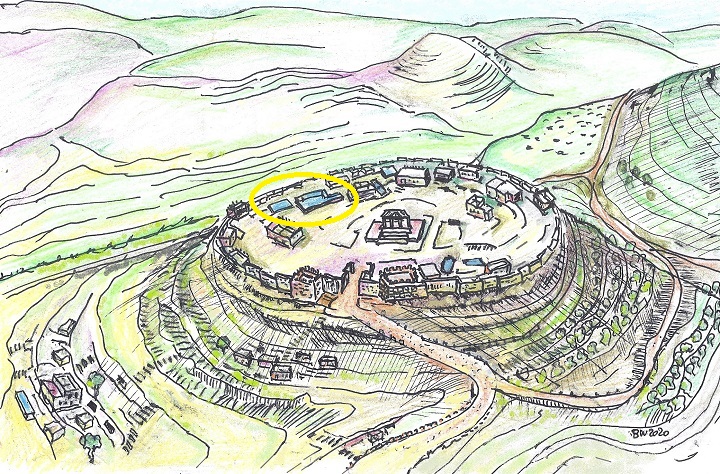
Dr. Dvir Raviv has mapped 5 of the known cisterns to date, marking them I thru V. The total volume of the reservoirs totals to 3,400 meter cube, enough to sustain the occupants’ need for water. He found a similarity in both shape, size and capacity to other Hasmonean desert fortresses. Dvir suggested that the cisterns were cut during the Hasmonean period, while cistern III may have been constructed during the Herodian period.
-
Cistern I
This cistern has a narrow vertical opening, from which the water was drawn out. A ladder was used to descend into it. Cistern I is rectangular in shape, has a depth of 7m and an area of 16 x 5.5m, with a total volume of 600m3.
-
Cistern III
An opening to another cistern (numbered III) had an easier access.
Cistern III is 5m deep, has an area of 15 x 5 m, and is cross-shaped. The following photo shows the northern section of the cistern.
The walls have a thick layer of white plaster, with a gray plaster over it, that sealed the cistern’s walls. This is a Hasmonean sealing method.
-
Miqveh (Ritual bath)
On the north west wing of the cistern is a Miqveh (Jewish ritual bath), dated to the Hasmonean period. It preceded the cistern and its entrance was from the opening. At a later time the southern wall was removed, its entrance blocked with silt, and the miqveh was then integrated into the newly built cistern.
The ritual bath includes a stepped entrance leading into a square immersion room (3.4m x 3.5m). The southern wall of the immersion room is now gone. In the immersion room were 5 steps cut into the width of the room. The walls of the ritual bath are sealed like the cisterns, covered with layers of grey plaster over a thick layer of white plaster.
-
Herodian fragment
Inside this cistern is a stone fragment that might have originated from a decorated facade of a monumental structure. This carved stone, 0.6m long by 0.4 x 0.4m, is similar to architectural fragments found in Herodian palaces, such as in Jericho.
A possible location of the palace is shown on the illustration on the summit of the hill.
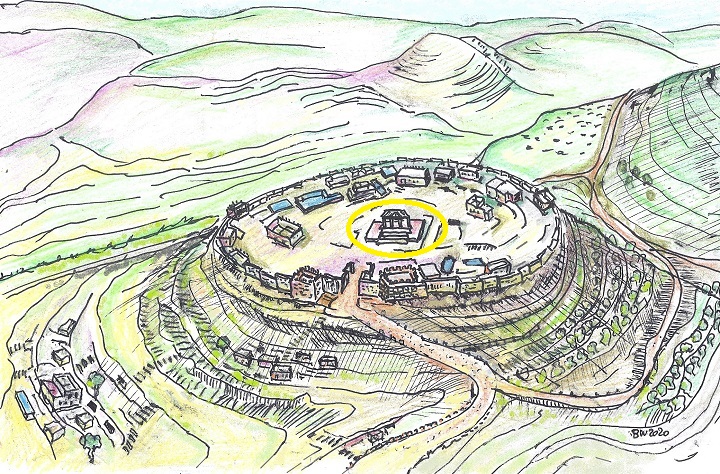
-
Cistern IV
A second miqveh was exposed near another cistern (IV), with a similar design. This cistern is the largest, 22m long and 4-10m wide, with depths up to 11m. It holds 1,200m3.
(e) Arches cave
On the southern foothills is an interesting cave – the arches cave. Initially it was thought to be a burial cave, such as found on other foothills. However, this cave had other functions.
The cave is close to the intersection of the descending road and the road to the Artabba spring.
There are several entrances to caves at this location.
The cave is beautifully carved in the form of arches. It has 3 chambers – one in the front and two in the back.
Not all of the soil that fills up the cave was removed, but one can admire the beauty of the construction.
The cave was constructed during the period between the revolts against the Romans (of 67-70 and 131-135 AD). Inside the cave the archaeologists collected 50 ceramic jugs, dating them to that period. The archaeologists suggest that the cave was used either for dwelling, or as a storage place, probably during the Bar Kokhba revolt.
Etymology (behind the name):
* Names of the site and vicinity:
- ‘Artabbeh’ or ‘Artabbah’ from Arabic as: ‘moist, fresh.’, based on the Arabic root word ‘ratb’=moist.
Links and References:
* External:
- “The Artabba Fortress: An Unknown Hasmonaean-Herodian Fortress on the Northern Border of Judaea” – Dvir Raviv 2018 , IEJ 68 V1 pp 56-76
- Unknown Hasmonean-Herodian fortress found (Walla Dec 18; Hebrew)
- Transfer of 3 provinces – Dvir Raviv, Cathedra 71 (2019)
- First visit to the Hasmonean water reservoir – Ynet Dec 2020 (Hebrew)
* BibleWalks nearby sites:
BibleWalks.com – tour the Bible Lands
Zereda <<<—previous Samaria site—<<<All Sites>>>—next Samaria site—>>> Kh. esh Shuna
![]()
This page was last updated on May 10, 2021 (heads and stretchers wall)
Sponsored links:
